
The Basics:
- For ages 12 and up (no suggested age minimum from publisher)
- For 4 or more players
- Approximately 60 minutes to complete
Geek Skills:
- Active Listening & Communication
- Counting & Math
- Logical & Critical Decision Making
- Reading
- Emotional Coping Skills
- Strategy & Tactics
- Cooperative & Team Play
- Hand/Resource Management
- Self-confidence
- Imagination
- Bluffing and Misdirection
Learning Curve:
- Child – Moderate
- Adult – Moderate
Theme & Narrative:
- Help close the gateway to the supernatural world before it’s too late!
Endorsements:
- Gamer Geek mixed!
- Parent Geek mixed!
- Child Geek rejected!
Overview
You couldn’t believe your luck when your dream home was on the market for such a low price. You suspected some sort of foundation or plumbing problem, but the house inspection came back with an “A+” rating. You purchased the home and moved in a few days later. A week after, strange things started to happen. Doors would open by themselves, keys would go missing, and the cat wouldn’t go into a certain rooms. You didn’t believe in ghosts, so it never bothered you. But when the blood started dripping from the walls and the smell of decay hung heavy in the air, you changed your mind. You have gathered a group of friends to help you purge whatever evil dwells in the house once and for all. Come dawn, either you will live in your dream home or something else will.
This House is Haunted, designed by Gabriel Gomez and published by Brain Punch Games, is comprised of 24 Seal cards, 15 Blessing cards, 20 Hex cards, 13 Haunting cards, 14 Curse cards, 24 Demon Mark cards, and 1 Leader card for a total of 111 cards. All the cards are as thick and as durable as your standard playing card. The artwork is stylized, minimal in presentation, and does a good job of furthering the game’s narrative.
It Begins…
Note: This House is Haunted is not a game you sit at the table to play. It requires players to move around and act strange in some cases. Obviously, the most important aspect of the game that is not included in the box are players willing to act silly. While the game does require the player to move to different rooms, you do not need a large home or apartment to play the game correctly. I should also add that the game is best played if you decorate the playing location a bit. Add cobwebs, scary music, creepy lighting, and pictures of clowns.
To set up the game, first establish a “Home Room”. This could be an actual room or a closet. The only object that must be present in the “Home Room” is a table or other flat surface. This table is referred to as the “Charm Circle” where some players will be working together to seal off the evil in the house and other players are attempting to keep the gateway open. You’ll need room for 3 different piles of cards. These are a “Collection Plate” (which the bottom of the game box can and should be used for), a discard pile, and a draw deck. The game rules suggest you decorate the table in the “Home Room” with candles and possibly spooky music. I like polka. I also suggest you make little name cards and place them where each player starts the game. This is important later on when players collect Curses.
Second, pick 3 to 8 other rooms or locations in the house/apartment/wherever to become “Haunted Rooms”. These are locations where players will be drawing cards and bad things happen. This could be another closet, the kitchen, or even a bathroom (see what I did there?). The game rules suggest these locations have a door or some other means to section off the location from other locations. Why will become apparent later and during the game.
Third, remove the Leader card and set it aside for now. Take the rest of the cards and shuffle them. Draw the first 13 cards and place them face-down in the “Home Room”. This is the “Home Room” draw pile. Depending on the number of other locations you have created, you will now make a pile of cards for each and as even as possible. If one location has more cards than another, it’s not that big of a deal. Take these piles and place them in each location, face-down. These are the “Haunted Room” draw piles.
Fourth, give one player the Leader card. This player has a big responsibility, which will be explained later in the review. For now, give it to a player who you think will crack easily under pressure, doesn’t like confrontation, and has a hard time making choices when stressed. I know, it sounds horrible. But it makes for a surprisingly more entertaining game when the Leader starts to fall apart.
That’s it for game set up. If you plan on turning off the lights or playing in locations where the lighting isn’t great, give everyone a flashlight. BIC lighters are cool, but tend to catch things on fire.
Time to fight the supernatural.
All About the Cards
This House is Haunted is driven by two things. The first is the willingness of the players to “get into” the game. Which is really very important. Second, and slightly less important, are the cards. The game has 6 different card types. These are Seal, Blessing, Hex, Haunting, Curse, and Demon Mark. Each are summaries here and all the card types have an identical layout.
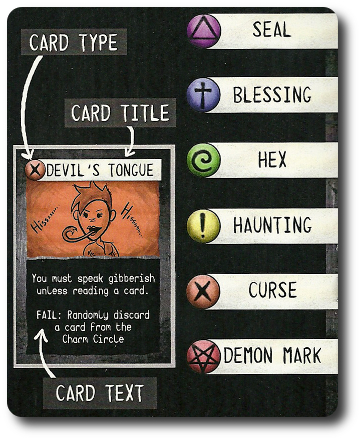
Seal Cards
The Seal cards represent magical incantations and runes that will close the gateway that is allowing evil into the house. Seal cards come in three different values (+1, +2, and +3) and directly counter Demon Mark cards. When found, players who are attempting to close the gateway place the Seal cards in the “Collection Plate” located in the “Home Room”.

Demon Mark Cards
The Demon Mark cards are the direct opposite of the Seal cards. While a Seal card slowly closes the supernatural gateway, the Demon Mark cards counter and keep the gateway open when placed in the “Collection Plate” in the “Home Room”. However, they also slowly corrupt the player who has them and eventually opens the player to demonic possession (thematically speaking). When a player has enough Demon Mark cards in their hand where the sum is -5 or fewer, they become possessed and have a new objective to win the game. Luckily for all the players, a possessed individual can be freed of demonic influence by reducing the sum of Demon Mark cards to -4 or greater. Demon Mark cards come in values -1, -2, -3, -4, and -5.
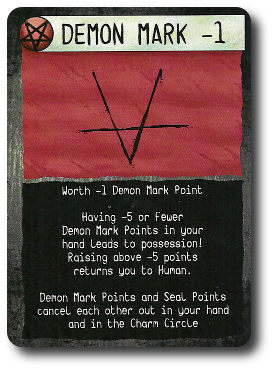
Hex Cards
Hex cards are not good. They tend to change things up, breaking chain of command, and cause temporary confusion. Which is pretty fun. A few Hex cards can also be played to the “Collection Plate” to cause some chaos.
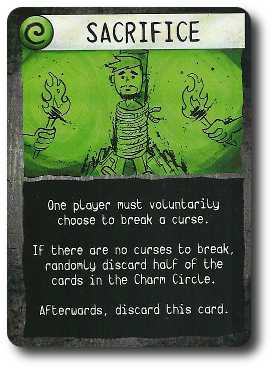
Curse Cards
Compared to Curse cards, Hex cards are like a gentle punch to the gut with a chicken feather. Curse cards are like being run over by a bulldozer. Curses affect players for the duration of the entire game until resolved. Worse yet, they are played face-up in the “Home Room” where the players are siting/standing so other players know exactly what is going on, easily identify any weaknesses, and limitations. Yep, it stinks. But even more interesting (and fun), Curse cards change how a player interacts with others and goes about playing the game. For example, finding 1 “Bear Trap” Curse card forces the player to hop around on one foot. If they are unfortunate enough to find the second “Bear Trap” Curse card, they have to crawl around! Failing to play to the Curse has even more dire consequences, often resulting in giving an advantage to the opposition. Since all the Curse cards are played face-up, everyone in the game is policing each other.
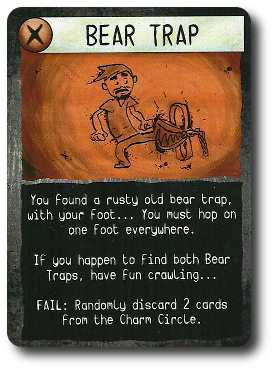
Blessing Cards
Thankfully, this game is not all doom and gloom. Blessing cards give players some special actions that can really save their butt during the game. Unfortunately, possessed players can use them, too. If used correctly and the timing is right, even the most demonically possessed player can make a Blessing card work to their advantage.
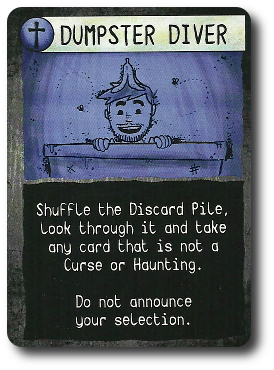
Haunting Cards
Haunting cards are essentially traps. If a player draws a Haunting card, they must read it and do what it says. If the player can successfully fulfill the Haunting card’s terms of release, they are freed. If they cannot, they remain trapped in to the location. Essentially, forever (well, not forever. Just until the end of the game). Even more interesting, to break the Haunting card’s trap, a player must interact with other players and get them to do things without actually telling them what they are doing or what they are looking for as a result of the interaction! Failure to meet the demands of the Haunting card can even trap other players!
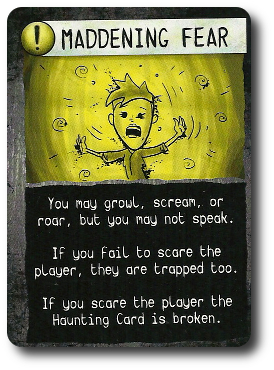
Haunting Your Game
This House is Haunted is played in 13 turns. Each turn is counted and kept track of by the draw pile in the “Home Room” (which, if you recall, has 13 cards). Each game turn is broken down into 3 phases which are summarized here. All turns start in the “Home Room”. But before we get into the phases, a few simple rules of play.
- Players should always keep the cards and the number of cards in their hand secret, unless forced to reveal them to another player.
- Player should always keep track of how many Demon Mark card points they have. If they ever have -5 or fewer points, their objective has changed. They should keep this a secret, however. If the total number of Demon Mark cards changes to -4 or greater, their objective changes back to the initial goal.
- If players notice another player failing a Curse card requirement, they should notify that player immediately. The “Fail” description is then read and resolved as soon as possible. The Leader then gets to look at half of the cards of the player who failed their curse! However, if a player notifies others that they failed to play the Curse card correctly, they must complete the “Fail” description but the Leader DOES NOT get to look through their cards. Which is pretty important if you are a possessed player or you think the Leader is possessed.
Phase 1: Search Rooms
The Leader assigns players to rooms. The goal is to assign players to go look for Seal cards, but the Leader might want to send some players to locations where they will get trapped or won’t cause too much difficulty. It all depends on what the Leader wants to accomplish. More than 1 player can be sent to the same room or split up in any way the Leader wants. It is, for example, OK to separate players and completely ignore rooms, but you cannot ignore players.
Note to Leaders: It’s possible that one or more players will become trapped in a room. You should send others in to free them, but don’t be surprised if your would-be rescuers become trapped to! If all the players get trapped, the haunting is broken and all the players are freed, but half the cards in the “Collection Plate” are discarded. Ouch!
After players get their assigned rooms, they go to them. Players enter the rooms one at a time and draw 1 card from the draw pile and read it to themselves. If the player is possessed, they draw 2 cards, select the one they want, and place the other card on top or bottom of the draw pile. After that, they do what the card says. Only 1 player should be in each location at a time until a card suggests otherwise. For example, Haunting cards.
Phase 2: Return to the Home Room
Those players who can leave the rooms return to the “Home Room” after they have drawn their card and wait for the other players to return. Any player who drew a Curse card should reveal it now and place it in front of them. The Curse is now active and the player must do what it says or face the consequences.
If the Leader did not return (due to being trapped), the next player to the left becomes the new Leader. Leaders can be “normal” players or possessed players. The Leader now takes 1 card from the “Home Room” draw pile and adds the card to the “Collection Plate”, face-down. Each player, in turn, now adds 1 card from their hand to the “Collection Plate”, face-down. This should be done under the table so none of the other players can see what cards are added. After each player has had a chance to add a card, the Leader takes all the cards in the “Collection Plate”, shuffles them, and reveals them one at a time, placing them on the “Charm Circle”.
- Seal and Demon Mark cards are placed directly into the “Charm Circle” and should be arranged so the values for both card types can easily be calculated.
- All revealed Curse cards (that came from the “Home Room” draw pile) are attached to the Leader.
- All Hex cards are resolved by the leader and then discarded.
- All Haunting cards are discarded.
Phase 3: Playing Cards
Players may now request cards from the “Charm Circle” they want to add to their hand. The Leader resolves any conflicts between 2 or more players who want the same cards and can deny any player a card request. After that, and starting with the Leader, each player can play 1 Blessing card from their hand, resolving it once played. Note that some Blessing cards are resolved later in the game or triggered by certain effects or during the next game turn.
Finally, the Leader card is passed to a new player of the Leader’s choice.
This completes the turn. A new turn now begins. starting with phase 1 noted above.
Unlucky Number 13
After the 13th turn ends during phase 3, the game ends as well.
First, all the players reveal if they are normal people or demonically possessed.
Second, the Demon Mark cards and the Seal cards are counted. Seal cards count as positive points and Demon Mark cards count as negative points. Each Curse card that remains unbroken (is played in front of the player) counts as 1 point for the player’s faction (+1 for normal players and -1 for demonically possessed players). Once the number of total points is determined, so is the winner.
The normal people win the game if the total number of points is equal to or greater than the number of players in the game. If not, the demonically possessed players win the game.
To learn more about This House is Haunted, visit the game’s web page.
Prediction
Games like This House is Haunted require a very special component that you cannot provide with the game: the right players. I have some “concerns” regarding my ability to fully review this game. The “right player” must be imaginative, creative, and above all else, completely fearless when it comes to making a fool out of themselves. This is what I like to call “getting into the game”. If a player doesn’t, the game will fail. Fail so hard as to make gamers in another country feel how painful the game play is. Given that, and assuming I can find the right players, here is how I think it’ll go down.
The Child Geeks are going to be mixed, at best. Although, I think most of the Child Geeks are either going to be weirded out seeing adults act strange or be frightened one too many times to consider This House is Haunted a game. The Parent Geeks who can get into the game are going to enjoy themselves. This is especially true if all the Parent Geeks who are playing know each other. If there are any third-wheels in the group, the overall energy of the game is going to be subdued. I must also consider the game’s narrative about possession of demons. That’s not going to go over well with some of our more conservative players.
Gamer Geeks…hmm…. Honestly, I think they are going to laugh this one off as a just strange game. I do think they’ll take note of the game’s subtle cooperative game play, betrayer mechanic, and sabotage. What I don’t think they’ll appreciate is the shenanigans, parlor tricks, and borderline live action role-playing (LARPing) that the game requires from its players.
Yeah, this could be an uncomfortable game to review…
Before you even think about teaching this game, you’ll need time to gather your props and set the house. The game suggests dark rooms, creepy props, and eerie atmospheres, but you should play to your audience. If you are playing with just adults, go nuts. Coat the walls with pig’s blood, play a Led Zeppelin recording in reverse, and poor strong drinks. If you’re playing with kids, go soft with dimly lit rooms, plenty of hall lighting, and festive Halloween decorations.
Teaching This House Is Haunted is really, really hard. There’s just too much to cover and there are a lot of nuances to the game that you cannot just talk about. You have to almost act everything out in order for the new players to get the game. Returning players and veterans of the game won’t have a problem, of course, and I suggest you ask them to help you explain the game and game play to new players. Do not be surprised if new players decide to bow out after you explain the game. The game play could sound too weird at times. I suggest you focus on the following points and let the rest of the game evolve naturally.
- Only 1 person in a room at a time, unless something happens to suggest that more than 1 can occupy the same room
- Always do as the card says, unless it’s impossible to do so
- Never let the other players know if you are a normal person or a demonic servant
Other than that, make sure everyone understands how the game is won (and lost) and that’s about it.
And so, after explaining and explaining and explaining and explaining this game to my 3 little geeks, I asked them their thoughts on the game so far.
“This is a very strange game, but I like the sound of it.” ~ Liam (age 10)
“I don’t think I will like being scared, Dad.” ~ Nyhus (age 7)
“I’m on your team, Daddy!” ~ Ronan (age 4)
Note that you MUST be able to read in order to play this game. If you have a Child Geek who cannot but wants to tag along, just team them up with someone and let them help you scare and figure things out. Two heads are always better than one when it comes to solving puzzles and creeping other players out.
Let’s play This House is Haunted and see if we have a frightfully good time.
Final Word
Our Child Geeks just didn’t enjoy themselves. There were moments where I thought their point-of-view would change, but it always ended the same: negatively. The game started out strong, but never crossed the finish line as a winner. The older Child Geeks enjoyed themselves longer than the younger Child Geeks, finding humor in Curse cards that force a player to act like a chicken or constantly telling folks “They are Human” (suggesting that maybe they are not), but the chuckles never lasted. According to one Child Geek, “I like the idea of this game, but I don’t really understand how to play it once it starts.” Another Child Geek said, “I’d rather just sit down and play a game.” Even when adults played, the Child Geeks shied away, finding weird acting adults to be – well – weird. Things quickly fell apart when the Child Geeks became tired of acting out their curses, stressed out from the jump scares, and simply didn’t care towards the end of the game if the house was sucked into a vortex or not. When all the games were over, it was clear that This House is Haunted is not a game the Child Geeks enjoyed.
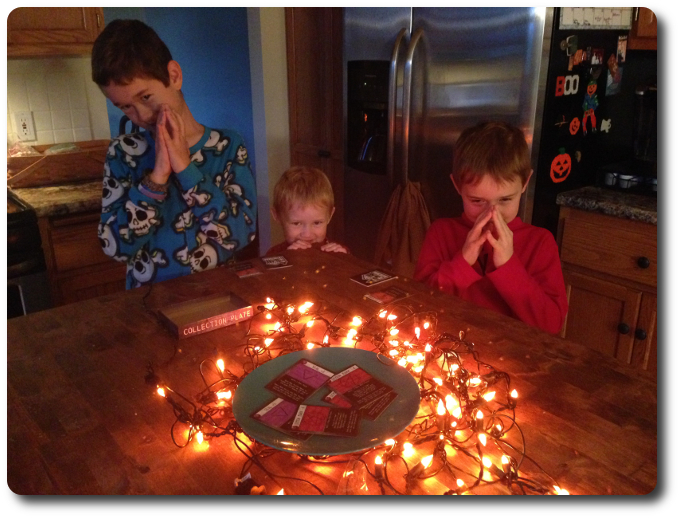
Hmm…I have a feeling I’m surrounded by “little devils”
The Parent Geeks had a much more positive and entertaining experience. When they played with their Child Geeks, it was obvious that they were holding back. When the Child Geeks were not included in the game, the fun really started. Of course, the level of “fun” was determined by how comfortable individual Parent Geeks were and with each other. If the group playing was comprised of close friends, the game was a good time. As expected, groups with a new member or a third-party didn’t reach the same level of energy. Finally, the game was not for every Parent Geek. The less social and more conservative Parent Geeks didn’t care for This House is Haunted whatsoever. According to one of these Parent Geeks, “I understand what the game is about, but I’m not big on acting like an evil entity and running around the house scaring people. It just sounds childish, mean-spirited, and beyond odd.” Another Parent Geek said, “I wouldn’t play this game with my kids. I think it would scare them and it just weirds me out.” But, for those Parent Geeks who didn’t mind the game’s theme or interactive play, This House is Haunted was found to be brilliant. According to one of these Parent Geeks, “A really neat concept. It reminds me of a LARP version of Betrayal at House on the Hill!” Another Parent Geek said, “This game is perfect for smaller gatherings of friends around Halloween. I could see this becoming a seasonal tradition.” When all the votes were in, This House is Haunted was both liked and disliked by the Parent Geeks.
The Gamer Geeks were amusing to observe because they went about the game in the same methodical way they would play a board game at the table. Which is to say, they attempted to gather the right cards, watched the other players like a hawk, and acted out a bit in the “Home Room” talking smack and making accusations. In fact, it was a bit like Are You a Werewolf at times. Players accused other players of being demons and so forth, hoping to help the Leader make choices when it came time to send people to rooms. Some of the Gamer Geeks really got into the curses and scares, while others rolled their eyes and loudly complained that this was a LARPing game. Which, if you didn’t know, is loved by some Gamer Geeks and despised beyond reason by others. According to one Gamer Geek, “I think this game has a lot of interesting things going on. Some are purely there for theatrics, but I like how players can be Cylons and some are humans.” The Gamer Geek is referencing Battlestar Galactica, a game where players could be good guys or bad guys and the victory condition for both groups are different. Everyone starts out as “human”, but as the game continues, some of the humans could become robots. The thing is, you never really know who is who. The same applies to This House is Haunted. As the game progresses, some people will become demons. Another Gamer Geek said, “I neat idea, but it’s not a strong game. It depends too heavily on the players to do all the heavy lifting. I don’t like playing games where everything is dependent on the players to keep everything going.” The Gamer Geeks were mixed when it came to approving This House is Haunted. Some enjoyed it while others clearly did not.
This House is Haunted is not a game for everyone. Heck, I don’t think it’s a game for me depending on my mood and energy level. It’s fun to play, but ONLY when you play it with the right people. Here’s my checklist of what I look for in my players.
- Outgoing
- Energetic
- Expressive
- Theatrical
- Creative
Just looking at the list, you can see that this game requires people who like being social. The board, dice, and card game hobby tends to lean a bit more towards the antisocial and quiet types, in my opinion. This would suggest that This House is Haunted is not a great game for gamers, but we now know that not to be true. This House is Haunted gives you everything you need to play a very interesting game that is one part mystery and one part theater. But it cannot be played right out of the box. Players must put forth a lot of effort both before the game and during the game to make it fun. That can be demanding and for some, unwelcome.
If find this to be a neat game with an enjoyable concept. I’m a fan of horror films and supernatural stories, so I was immediately interested when I found out about the game. I wasn’t surprised to learn how much effort the game took to play, but I was delighted when I found all the wonderful game elements. Logical thinking, cooperative game play, hand management, bluffing, and lots of memory usage is required. Good stuff. This is a game that made me think, made me smile, made my yelp (I was frightened a number of times), and laugh with hysterical evil glee. I can’t remember the last time a game made me do that. Unfortunately, This House is Haunted is not a game I will be able to play often. You need the right people and that is going to hold this game back.
If you have a group of friends and family who like things that go bump in the night, acting foolish, and laughing all the while, do take a look at This House is Haunted. It just might fill you with thrills and chills.
This game was given to Father Geek as a review copy. Father Geek was not paid, bribed, wined, dined, or threatened in vain hopes of influencing this review. Such is the statuesque and legendary integrity of Father Geek.



